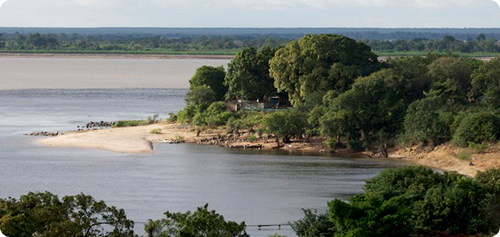Gimlette, John. Wild Coast: Travels on South America’s Untamed Edge, Alfred A.Knopf, New York, 2012 (358pp.$28.95)
The ungodly thrills and horrors of the wild coast—a stretch of 900 miles between the mouths of the Orinoco and the Amazon rivers in South America, first came to European attention through the medium of the miasmic and somewhat phantasmagoric imagination of Sir Walter Raleigh, whose account of his travels there (“The Discoverie of the Large, Rich and Bewtiful Empire of Guiana”), published in 1556, inspired the English to think of this area as a rich land peopled by Amazon maidens who lived in golden cities. The truth about modern Guyana, Surinam and French Guiana (as this pastiche of coastal swamp, jungle and inhospitable interior savanna adumbrated by flat-topped Cambrian mountains is now named) is somewhat more complex.
The much admired English barrister and amateur voyagueur John Gimlette has written an astoundingly erudite, witty, detailed and thoroughly enthralling travel book about these difficult, dangerous and often haunting lands that are so dark and uninhabited—creased by thousands of turbulent rivers (replete with waterfalls and rapids), stalked by peevish caimans and alligators, and otherwise filled with gigantic and voracious tropical otters, all patrolled by mosquitoes carrying dengue and malaria parasites, that they do not show up on modern satellite photos at night.
Gimlette, celebrated as the writer of pervious books about Paraguay and Labrador/Newfoundland, undeterred by all manner of discomforts (nights spent in lean-tos under a driving hot rain), dangers (hotel in a lawless town overseen by a shotgun-toting landlord), and social demands (did he really drink that cassiri home-brew made of cassava, purple potatoes and human spit?), manages to visit not only the major towns of the coast like Georgetown, Paramaribo and Cayenne (blowsy wooden affairs which are lacy, ramshackle, dysfunctional and mysterious) but also to delve far inland along rivers up and down, along which he is guided by a host of fishermen, pilots, traders and farmers who usually operate shallow motorized pirogues. Always undaunted, Gimlette is everything a travel writer should be: Brave, optimistic, hardy, languid, contemplative, observant and crazy.
These days the coast consists of Guyana (the former British colony), Suriname (former Dutch colony) and French Guiana (still French). Slavery is the single most important historical fact about these places. Flying along the coast one can still see the sugar and coconut plantations that defined life for hundreds of thousands of Africans until the revolutions of 1848.
No people died quite so willingly for conquest as the Dutch, who were on the coast from 1595 until 1977, arriving long before the English, staying on to drink themselves into oblivion and to die in astounding numbers from fever, flux and heat. These days indigenous people make up only 3 percent of the population. Originally treated as souvenirs by the European (taken back to Italy to serve at the court of the Medicis, for example), people like the Macushi and Wapisianas now live deep against the southern savanna eking out a living as slash-and-burn farmers and hunters. The rest of the population is an admixture of various peoples, indigenous and newcomer.
With slavery ended, a period of East Indian indenture ensued, with almost a quarter of a million Hindus arriving on the coast, along with Javanese courtesy of the Dutch. Servants like these were confined to plantations, flogged, starved and overworked. Prior to 1950, there had been at least 16 major slave and servant revolts in the territories, adding physical terror to the coast’s already formidable miseries.
Today, the wild coast is hard to assimilate—three countries each the size of Florida, with one in six inhabitants (only about 250,000 in total) descended from escaped slaves. Most of the population believes in jungle ghosts. Writers like the esteemed V.S. Naipaul who deemed the placed “destructive and predatory” and Evelyn Waugh who deemed the people “slatternly and ill-favored,” gave up on the place almost immediately. Not so Gimlette, who not only travels to the dreaded interior, but also visits such lowlights as Jonestown in Guyana, where Reverend Jim Jones managed to take 900 of his acolytes to their promised reward of death via poisoned purple Kool-Aid, as well as Devil’s Island, where the French imprisoned a parade of criminals and political undesirables until 1947.
Gimlette manages to impart a subtly detailed history layered with acute social observation of the contemporary scene in stylistically exciting ways. If Gimlette lacks an eye it is the naturalist’s bent for ecology and taxonomy. Otherwise his observations are letter-perfect. The book itself, as a physical object, is ethereally beautiful, with lovely colophons, illustrations, title heads and deeply plush paper with ragged edges. Gimlette’s book is an instant classic, making it possible for the rest of us to be there and not to be there, the author having done all the hard, exhausting work.


